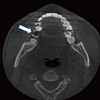Abstract
A healthy 34-year-old man was admitted to the intensive care unit through the emergency room with a drowsy mentality and severe chilling. Following a diagnosis of septic shock of unknown origin, the patient was treated with broad spectrum antibiotics and massive hydration. After recovery of consciousness, he complained of a severe toothache that originated from the right lower teeth. Under dental consultation, he was diagnosed as having an acute periapical abscess of the right mandibular first molar. The patient underwent extraction and cyst enucleation. Gram negative bacilli isolated from blood culture on day 5 after admission were identified as Prevotella species. After receiving antibiotic treatment and undergoing dental procedures, the patient made a full recovery. We report on a case of septic shock due to infection by Prevotella species in association with an acute periapical abscess.
Figures and Tables
References
1. Yoon JY, Choo EJ, Choi SH, Kim MN, Kim NJ, Kim YS, Woo JH, Ryu JS, Chang MS. Clinical characteristics and outcome of invasive prevotella infection. Korean J Med. 2003. 64:254–259.
2. Shah HN, Collins MD. Proposal for reclassification of Bacteroides asaccharolyticus, Bacteroides gingivalis and Bacteroides endodontalis in a new genus, Porphyromonas. Int J Syst Evol Microbiol. 1988. 38:128–131.

3. Shah HN, Collins DM. Prevotella, a new genus to include Bacteroides melaninogenicus and related species formerly classified in the genus Bacteroides. Int J Syst Bacteriol. 1990. 40:205–208.

4. Jousimies-Somer H, Summanen P. Recent taxonomic changes and terminology update of clinically significant anaerobic gram-negative bacteria (excluding spirochetes). Clin Infect Dis. 2002. 35:Suppl 1. S17–S21.

5. Lorber B. Mandell GL, Douglas RG, Bennett JE, editors. Bacteroides, Prevotella, Porphyromonas, and Fusobacterium species (and other medically important anaerobic gram-negative bacilli). Principles and Practice of Infectious Disease. 2009. 7th ed. Philadelphia: Churchil Livingstone;3111–3119.
6. Nguyen MH, Yu VL, Morris AJ, McDermott L, Wagener MW, Harrell L, Snydman DR. Antimicrobial resistance and clinical outcome of Bacteroides bacteremia: findings of a multicenter prospective observational trial. Clin Infect Dis. 2000. 30:870–876.

7. Bouza E, Reig M, Garcia de la Torre M, Rodríguez-Créixems M, Romero J, Cercenado E, Baquero F. Retrospective analysis of two hundred and twelve cases of bacteremia due to anaerobic microorganisms. Eur J Clin Microbiol. 1985. 4:262–267.

8. Vazquez F, Mendez FJ, Perez F, Mendoza MC. Anaerobic bacteremia in a general hospital: retrospective five-year analysis. Rev Infect Dis. 1987. 9:1038–1043.

9. Marina M, Strong CA, Civen R, Molitoris E, Finegold SM. Bacteriology of anaerobic pleuropulmonary infections: preliminary report. Clin Infect Dis. 1993. 16:Suppl 4. S256–S262.

10. Wexler HM, Finegold SM. Current susceptibility patterns of anaerobic bacteria. Yonsei Med J. 1998. 39:495–501.

11. Lee K, Chong Y, Jeong SH, Xu XS, Kwon OH. Emerging resistance of anaerobic bacteria to antimicrobial agents in South Korea. Clin Infect Dis. 1996. 23:Suppl 1. S73–S77.

12. Castillo DM, Sánchez-Beltrán MC, Castellanos JE, Sanz I, Mayorga-Fayad I, Sanz M, Lafaurie GI. Detection of specific periodontal microorganisms from bacteraemia samples after periodontal therapy using molecular-based diagnostics. J Clin Periodontol. 2011. 38:418–427.

13. Lee JJ, Hahn LJ, Kao TP, Liu CH, Cheng SJ, Cheng SL, Chang HH, Jeng JH, Kok SH. Post-tooth extraction sepsis without locoregional infection--a population-based study in Taiwan. Oral Dis. 2009. 15:602–607.

14. Bassa A, García-Gasalla M, Losada IA, Payeras A, Pareja A, Garau M, Gallegos C. Anaerobic bloodstream infections: study of 68 episodes. Enferm Infecc Microbiol Clin. 2010. 28:144–149.
15. Lee KW, Shin WS. Clinical characteristics and outcome of invasive prevotella infection. Korean J Med. 2003. 64:245–246.




 PDF
PDF ePub
ePub Citation
Citation Print
Print




 XML Download
XML Download